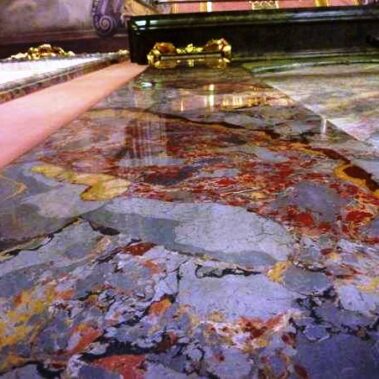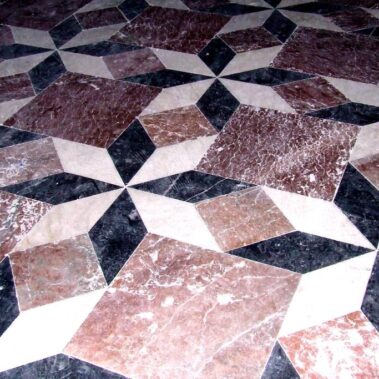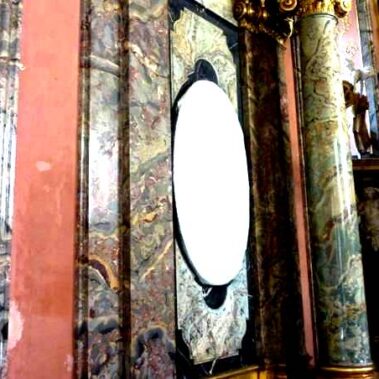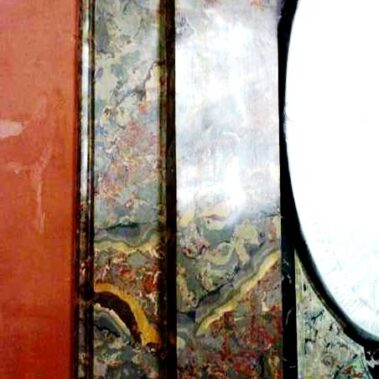Clementinum, Prague - Old Town, Czech Republic

| Address: | Mariánské nám.190/5, 110 00 Praha 1 |
|---|---|
| Description of work: | Restoration of artificial marbles
Restoration of metal elements |
| Contractor: | GEMA ART GROUP a.s. |
| Investor: | Metrostav a.s. |
| Implementation: | 07/2011 |

Archaeological research carried out in May 2010 confirmed the existence of a medieval urban settlement on the site of today’s Clementinum. The name derives from the original Chapel of St Clement and the adjacent Dominican monastery, which stood here from the first half of the13th century. The monastery was destroyed in 1420 during the Hussite wars and the resident monks killed or driven away. The monastery was partly renovated by the members of a Polish Dominican order, who made its buildings habitable towards the end of the 15th century. In the spring of 1556 the Jesuit Order, headed by the Provincial Father Peter Canisi, arrived in the Czech Lands on the invitation of the Emperor Ferdinand I and the leaders of the Catholic Church hierarchy. The Jesuits were given three options for their accommodation and chose the dilapidated building of the Dominican monastery in Prague’s Old Town. The last of the Dominican monks moved to the Prague monastery “Na Františku”.
The Jesuit College was built in several stages. The first buildings were erected between 1560 and 1561 according to a design by the Renaissance architect Bonifác Wolmut, followed by an addition of a school wing in the years between 1576 and 1577 and of the Church of the Most Holy Saviour (or Salvator). The most intensive period of building activity took place in the era of the Early and High Baroque, between the years 1653 and 1726, with subsequent work on the decoration of the interiors. Many important Baroque architects and artists took part in the construction of the Clementinum: Carlo Lurago, Giovanni Domenico Orsi di Orsini, František Maxmilián Kaňka, Kilián Ignác Dientzehofer, Giovanni Battista Passarini, Francesco della Torre, Matyáš Bernard Braun, Josef Kramolín, Václav Vavřinec Reiner, Jan Hiebl and many others. Foremost among the architectural highlights are the Church of the Immaculate Conception of the Virgin Mary, The Mirror Chapel (formerly called the Chapel of the Annunciation of the Virgin Mary), the Baroque Library Hall and the Astronomical Tower. The Jesuit Order remained in the Clementinum until 1773, when this so-called Society of Jesus was abolished by Pope Clement XIV. During their residence the Jesuits established the Clementinum as a centre of education and in 1616 their college was elevated to the status of university by the Emperor Matyas. Many scholars, both local and foreign, worked there and had at their disposal an extensive library collection. The foundation of the library dates back to the Dominican monastery era and the book collection was later supplemented by transfer of stock from the Jesuit monastery in Ojvín in Upper Lusatia.
After the Jesuits left, the Clementinum was first converted into a holding prison for participants in the peasant rebellion of 1775 and then into a printing works. In 1777 the Empress Maria Theresa issued an official decree for the foundation of a public university library in the premises of the Clementinum, which were at the same time partly remodelled in the Classicist style according to the design of the architect Matyáš Hummel.
The next significant building alterations of the complex, work of the architect Ladislav Machoň, were carried out between the years 1924 and 1936. The concrete book storage area, the reader services hall and the Otto Gutfreund sculptures date back to this time. The most recent modernization of the user facilities and the restoration work within the Clementinum complex commenced in March 2010, with the conclusion of the work scheduled for 2016.
Restoration work carried out under the management of the GEMA ART GROUP a.s. within the framework of general reconstruction and modernization of the Clementinum complex begun in 2009, involved the restoration of artificial marbles and metal parts in the architecturally most valuable parts of the Clementinum: the Baroque Library Hall and the Mirror Chapel. Other restoration work in these two areas involved renovation of the windows, parts of the flooring and the chapel organ. All the work was undertaken between January and July 2011.
Restoration of metal parts:
Restoration of metal parts involved work on the railings and window fixtures in the Baroque Library Hall and on the small metal grilles in the Mirror Chapel. The surfaces of the metal parts were corroded and covered in dirt. The restoration survey of the wrought iron railings uncovered the presence of the original gold leaf plating. The unsuitable black paint on the railing was removed, residual defects retouched and the surfaces treated with Damar varnish. The gilding was also retouched.
The window fixtures and the metal grilles above the door to the choir were cleaned and given an anti-corrosive treatment followed by an application of a protective coating. A missing window fixture was replaced by an identical copy.
Restoration of the artificial marbles:
This work concerned the renovation of the artificial marble cladding in the Mirror Chapel. The surface of the marble exhibited cracks and mechanical damage. The surfaces were cleaned and any old wax residues removed using an ammonia solution. The most extensive cracks were infilled with plaster of Paris. Care was taken not to affect the surrounding areas of polished marble by this material.
Minor defects were dealt with using hard beeswax. Beeswax dissolved in turpentine and linseed oil was applied for final re-polishing.





































